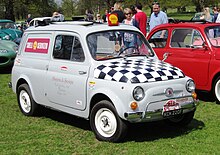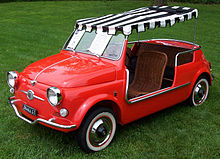Fiat 500
| Fiat 500 | ||
|---|---|---|
Kerb weight 499 kg (1,100 lb) | | |
| Chronology | ||
| Predecessor | Fiat 500 "Topolino" | |
| Successor | ||
The Fiat 500 (
Launched as the Nuova (new) 500 in July 1957,[2] as a successor to the 500 "Topolino", it was an inexpensive and practical small car. Measuring 2.97 metres (9 feet 9 inches) long, and originally powered by a rear-mounted 479 cc two-cylinder, air-cooled engine, the 500 was 24.5 centimetres (9.6 inches) smaller than Fiat's 600, launched two years earlier, and is considered one of the first purpose-designed city cars.[citation needed]
In 1959, Dante Giacosa received a Compasso d'Oro industrial design prize for the Fiat 500. It was the first time when it was awarded to an automotive industry.[3]
History
In 1936, Fiat released the front engine
.Despite its very small size, the 500 proved to be an enormously practical vehicle with large sales throughout Europe. Besides the two-door coupé, it was also available as the "Giardiniera" estate; this variant featured the standard engine laid on its side, the wheelbase lengthened by 10 cm (3.9 in) to provide a more convenient rear seat, a full-length sunroof and larger brakes from the Fiat 600.
Sports models were produced by Abarth, as well as by Giannini. An Austrian variant, produced by Steyr-Daimler-Puch, the 1957–1973 Steyr-Puch 500, had a Puch boxer twin motor, a sports model of which was the 1965–1969 Steyr-Puch 650 TR2.
Production of the 500 ended in 1975, although its replacement, the Fiat 126, was launched two years earlier. The 126 was not as successful as its predecessor in Italy, but sold well in the Eastern Bloc countries, being assembled and manufactured in Poland as a Polski Fiat. The Fiat 500 has a Cx (aerodynamic resistance coefficient) of 0,38, a very good performance for its time.
In 2006 the magazine Top Gear voted the Fiat 500 "the sexiest car"[4]
In 2007, the 50th anniversary of the Nuova 500's launch, Fiat launched another new 500, stylistically inspired by the 1957 Nuova 500, featuring a front-mounted engine and front-wheel drive.
In 2017 Fiat celebrated the 60th anniversary with an exhibit at the
Models
Nuova 500 (1957–1960)

The 500 features a 479 cc (500cc nominal)
Including the Sport model, in total 181,036 examples of the Nuova 500 were produced from 1957 until 1960.[8]
Nuova 500 Sport (1958–1960)
In mid-1958 Fiat introduced the Nuova 500 Sport, featuring a more powerful engine and a two-tone livery—white with a red stripe along the flanks. Unique to the Sport was an all-metal rigid roof with three longitudinal grooves. A short-open-roof model was added a year later, in 1959.[9]
Coded type 110.004, the 500 Sport's two-cylinder engine had been bored out to 499.5 cc from the original 479 cc (bore and stroke now 67.4 × 70 mm), giving it a very respectable horsepower with the same block: 21.5 PS (15.8 kW; 21.2 hp). Top speed was over 105 km/h (65 mph).[9]
500 D (1960–1965)

Replacing the original Nuova in 1960, the D looks very similar to the Nuova, but there are two key differences. One is the engine size (the D features an uprated 499 cc engine producing 17 bhp as standard—this engine is used right through until the end of the L in 1973) and the other is the roof: the standard D roof does not fold back as far as the roof on the Nuova, though it was also available as the "Transformable" with the same roof as the Nuova. The D also features "suicide doors".
In New Zealand, where it was locally assembled by Torino Motors, the 500 D was sold as the "Fiat Bambina" (Italian for "baby"), a name that is still in use there to describe this car.[10]
500 Giardiniera (1960–1968)

The 500 Giardiniera (500 K on some markets)

500 Furgoncino
A panel van variant of the Giardiniera (estate) was offered as the Furgoncino.[12]
500 F or Berlina (1965–1972)

The F spans two periods of 500 production, the D and the L. As such, it is the most frequently misidentified model. Between 1965 and 1969 the F carried the same badging as the D, but the two models are distinguishable by the positioning of their door hinges. The D has "
500 L or Lusso (1968—1972)

In September 1968 Fiat put on sale the 500 L or Lusso (tipo 110 F/L), a more richly trimmed and better appointed version of the standard 500 F.[13][14] The 500 L remained on sale until 1972, when the new Fiat 126 was introduced.[13]
Perhaps the most obvious new feature of the 500 L were tubular guards protecting the front bumper and the corners of the rear one. As a result, the car was about 6 cm (2.4 in) longer than the 500 F at 3,025 mm (119 in).

500 R or Rinnovata (1972—1975)
The last incarnation of the Fiat 500 was the R model, or "Rinnovata" (Renovated). Launched alongside the new

Fiat 500 America
During the years in which it was produced the 500 in Italy, Fiat designed and produced a US-market version of the car with prominent headlamps (also used on the American 500 Jolly). About 300 were made between 1958 and 1962.[15]
Derivatives


Abarth 695 SS (1964–1971)
Of all the performance-oriented models created by Karl Abarth, later known as Carlo Abarth, perhaps the 695 esse esse is the best representation of the scorpion-branded firm's collaboration with Fiat. Around 1,000 Fiat Abarth 695 SS were produced and only 150 are believed to remain.
Abarth introduced its 695 SS version in 1966, after the previous presentation back in 1964.[16] The rear-engine, rear-wheel-drive layout Fiat 500 was the basis of the project. When compared to the production version of the 500, aesthetically the 695 was virtually identical except for the logo, badge on the radiator grille and the coat of arms on both sides of the car. The 695 SS was the only version to feature flared arches and the need to raise the engine cover for extra stability and cooling.
Like all Abarths, the differences are found in the mechanical upgrades that helped to increase its top speed to around 140 km/h (87 mph). The

Fiat 500 Jolly Ghia
2007 Fiat 500
First announced in May 2006, Fiat previewed an all-new four-seat three-door hatchback 500 model in March 2007 – fifty years after the first Fiat 500 was presented. The design of the 2007 Fiat 500 is based on the 2004 Fiat Trepiùno concept.
The new model features a distinctive
The 500 is also offered in Abarth trim, with 1.4L Turbo Petrol engine, sport exhaust, suspension, and transmission.
The Fiat 500
See also
- Autobianchi Bianchina – based on the Fiat 500 mechanicals.
- Giannini Automobili - Abarth's main competitor for selling tuned 500s.
- Fiat 126 – successor to the Fiat 500 in many markets.
- Zastava 750 – a similar car produced by Yugoslavia's Zastava
- Fiat 500 "Topolino" – the predecessor, and "original" 500.
- Fiat 600 – the model above the 500, only slightly larger in size and engine displacement.
- Fiat Cinquecento – "five hundred" in Italian.
- Fiat 500X – a mini SUV
- Puch 500 – the Austrian licence produced version.
- BMW 600 – introduced in the same year, the only four-seat car that was even shorter than the 500.
References
- ^ a b c d e Bouchat, Christian (19 June 2007). "Fifty years since the launch of the Fiat 500 (Part II)". automania.be. Archived from the original on 5 December 2014.
- ^ a b c "Used Car Test: Fiat 500D". Autocar. 818 (130): 49–50. 17 April 1969.
- ^ "Fiat - The people". fcaheritage.com. Retrieved 6 December 2020.
- ^ Patton, Phil (17 Sep 2006). "A Pinch of Retro Spices Up Fiat's Classic Italian Recipe". The New York Times. Retrieved 27 Oct 2023.
- ^ ""Fiat 500 entra al MoMA" e vince il Corporate Art Awards 2017". La Repubblica (in Italian). 22 November 2017. Retrieved 26 March 2018.
- ^ "Corporate Art Awards - Corporate winners". pptArt. 22 November 2017. Retrieved 26 March 2018.
- ^ "Il Presidente Mattarella ha ricevuto i partecipanti al Convegno "Mecenati del XXI secolo"". The president of the Republic (in Italian). 22 November 2017. Retrieved 26 March 2018.
- ^ Fiat—Tutti i modelli del Novecento I, p. 316–317.
- ^ a b Fiat—Tutti i modelli del Novecento I, p. 328–329.
- ISBN 0-7900-0846-7
- ^ "FIAT 500 Giardiniera". nuova500.free.fr (in Italian). Retrieved 18 September 2019.
- ^ Fiat 500 Model History, www.fiat500enthusiasts.co.uk Retrieved 22 June 2015
- ^ a b c d Fiat—Tutti i modelli del Novecento I, p. 426–427.
- ^ Bernabò, Ferruccio (25 August 1968). "Una nuova "Fiat 500" più elegante e comoda" [A new "Fiat 500" more elegant and more comfortable]. La Stampa (in Italian). p. 10. Retrieved 18 March 2017.
- ^ Carlsson, Mårten. "Fiat med nya ögon". Klassiker. Retrieved 20 August 2019.
- ^ "How to identify a 1964-1971 Fiat Abarth 695 esse esse (SS)". Classicregister.com. 9 May 2015. Retrieved 2018-08-17.
- ^ Pawel Zal (ed.). "1966 Fiat Abarth 695 SS". Automobile-catalog.com. Retrieved 2018-08-17.
- ^ Osborne, Donald (September 2005). "1961 Fiat Jolly 500". Sports Car Market. Archived from the original on 21 June 2013. Retrieved 27 April 2015.
- ^ "1962 Fiat Jolly 500". Microcar Museum. 2002. Retrieved 27 April 2015.
Sources
- Abarth 595 695, Elvio Deganello and Renato Donati, Giorgio Nada, 2002 ISBN 88-7911-287-2
- Album Fiat 500, di J.J. Galkowsky, EPA Edition ISBN 2-85120-470-X
- Autopassion Hors Serie, Auto collection n. 22
- Fiat & Abarth 500-600, Malcolm Bobbit, Veloce Publishing ISBN 1-903706-69-6
- Fiat 500, Elvio Deganello, Giorgio Nada, 2002 ISBN 88-7911-069-1
- Fiat 500, Alessandro Sannia, Motorbuch-Verlag, Stuttgart 2007, ISBN 978-3-613-02825-8.
- Fiat 500 – az apró, mégis óriási legenda, Alessandro Sannia, Alexandra, 2006, ISBN 963-369-555-4.
- Fiat 500 – de kleine grote mythe, Alessandro Sannia, Rebo, 2006, ISBN 90-366-1875-4
- Fiat 500 fuoriserie, Alessandro Sannia, All Media, 2003
- Fiat 500 (genio di un'epoca), Ugo Castagnotto and Anna Maria Quarona, Lindau, 1992 ISBN 88-7180-039-7.
- Fiat 500 – guida al restauro, Marcello Lo Vetere and Italo Grossi, Giorgio Nada, 2003 ISBN 88-7911-209-0.
- Fiat 500 Gold Portfolio 1936–1972, R.M. Clarke, Brooklands ISBN 1-85520-246-8
- Fiat 500: la Guida – the Guide, Alessandro Sannia, All Media, 2003
- Fiat 500 – l'evoluzione del mito, Alessandro Sannia, Gribaudo, 2007, ISBN 978-88-7906-385-2
- Fiat 500 – piccolo grande mito, Alessandro Sannia, Gribaudo, 2005, ISBN 88-7906-020-1.
- I miei 40 anni alla Fiat, Dante Giacosa
- Il grande libro delle giardinette Fiat, Alessandro Sannia, Giorgio Nada, 2007, ISBN 978-88-7911-401-1.
- Io Franco Giannini vi racconto, Franco Giannini
- La 500, by Romano Strizioli, pub. by Bacchetta
- La Fiat 500 – Storia di un mito, Stefano Parenti, Polo Books ISBN 88-87577-26-9.
- La Fiat Nuova 500, Enzo Altorio, Automitica, 2005 ISBN 88-86304-00-5
- La Fiat 500 de mon père, Lauvrey - Le Fay, E.T.A.I. 1998 ISBN 2-7268-8178-5
- Le Giannini, Enzo Altorio, Automitica
- "Fiat 500" Topolino, Paulo Felizes, Matosinhos: Cardume, 2016 ISBN 978-989-99589-9-9
- Progetti alla Fiat prima del computer, ISBN 88-85880-00-2.
- Revue Technique Automobile 500, D, F, L, ì E.T.A.I.
- Fiat 500, 600 : mit Topolino, Jagst, Multipla und Weinsberg; 1936–69; eine Dokumentation, Schrader Verlag, München 1987, ISBN 3-922617-26-3.
- Fiat—Tutti i modelli del Novecento. Vol. I. Editoriale Domus. 2010.
